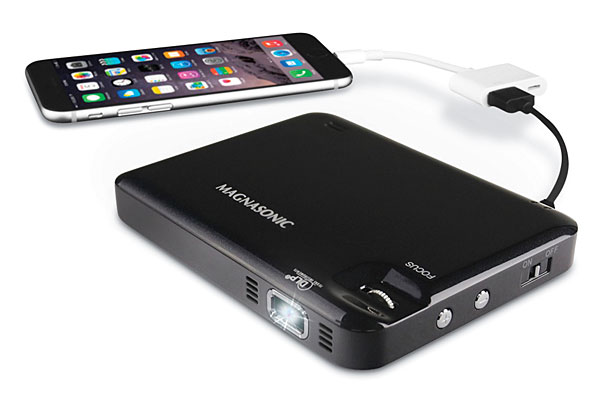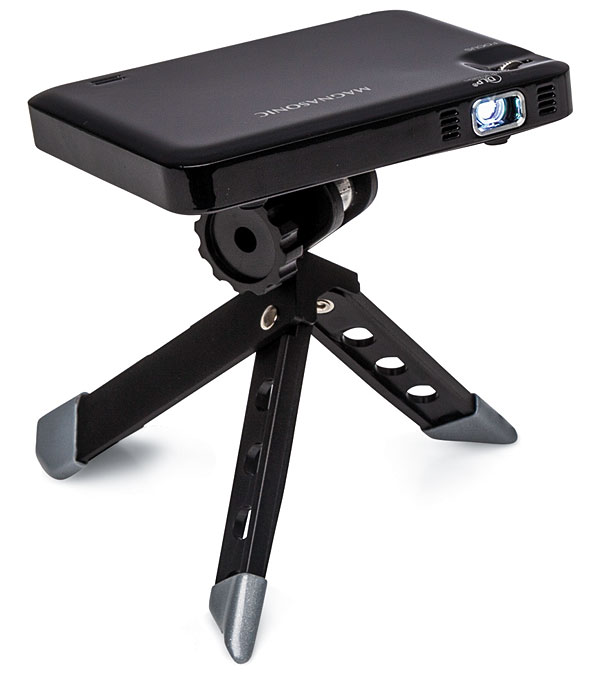Magnasonic PP60 DLP LED Projector
PRICE $170
AT A GLANCE
Plus
Incredibly small and lightweight
Uncomplicated operation
Minus
Best with small image size
Only two hours on a battery charge
Mono audio output
THE VERDICT
Don’t expect much more than utilitarian image quality, but the diminutive Magnasonic PP60 is a fun product that provides ultimate portability and delivers fair value.
Magnasonic claims that this is “the world’s smallest portable DLP projector,” and I don’t doubt it. The PP60 is only a touch bigger (and thinner) than a pack of playing cards, and it barely tips the scale at 4.5 ounces; it’s hard to accept that any functional projector could fit in such a tiny, lightweight form factor. It carries a $300 list price but is promoted on Magnasonic’s website for $170, so I’ve evaluated it in that context.

You do sacrifice brightness and picture detail for the PP60’s size and portability, as it’s rated for only 25 lumens of light output and a somewhat meager 640 x 360 pixel resolution. But you get a fair amount for your money: It’s well thought out and reasonably well performing (considering the form factor), and it comes with a nice mix of cables and accessories. The built-in battery gives you two hours of play time before requiring a three- to five-hour charge from your computer or phone charger—perhaps a bit short for some movies or a sports event. A single HDMI input accepts signals up to 1080p and is MHL compliant for connection to compatible smartphones. Magnasonic includes a short standard HDMI cable, a micro-HDMI-to-HDMI adapter, an MHL adapter, and a 5-pin/11-pin converter for Samsung Galaxy phones. There’s a small carry bag for travel and a cute little fold-up plastic tripod that should come in handy for table or counter setup.

Controls here are about as straightforward as they get—no fancy picture adjustments or even a menu to navigate, which guarantees very simple setup and operation. An on/off slider and a pair of up/down volume buttons are on one side, and the HDMI input, micro-USB charging port, and 3.5mm headphone output are on the other side. (Oddly, the headphone output delivered only the left channel of a stereo HDMI signal to my hi-fi rig and a pair of headphones I plugged in; I assume it’s a mono output, though that probably won’t matter with most portable speakers.) The tiny speaker fires off the top, and there’s a mechanical thumbwheel above the lens opening to adjust focus. And...you’re done.
Recommended image size starts at 10 inches—no bigger than the average tablet, really—and tops out at 60 inches diagonal, 5 inches smaller than my target. To be a little more fair, I evaluated mostly at 50 inches, though the picture still lacked any real punch, and it turned out that 30 to 35 inches diagonal gave me a more satisfying experience, improving both sharpness and contrast. (Achieving 12 ft-L brightness required an even smaller image of just 21 inches.) There were some odd halo-like reflections cast near the lower right corner of the image, but they were noticeable only on black transitions. I also spotted some occasional brightness pumping I couldn’t explain, but again, nothing that was particularly bothersome. And in an early scene of Ex Machina, when Caleb (Domhnall Gleeson) is approaching the entry to his boss’s compound, the projector struggled with some motion artifacts and moiré on the vertical slats of the gray wood fence as the camera panned across it. Again, such an inexpensive product can’t be chastised for this.

Even with a smaller, punchier image, I couldn’t help my expert eye from seeing everything that was right or wrong: pretty good, though not great, color accuracy (such as in the hyped greens of the tall grass in the opening of Rogue Nation) and skintones that were acceptable but ultimately too red. Focus was about what you’d expect from a lens opening smaller than the diameter of a pencil eraser—a touch soft but (with careful adjustment) sharp enough to allow me to get sucked into the program. Not surprisingly, shadow detail was hard to come by, as the image tended to crush blacks in the name of delivering more impactful contrast.
Let’s put all that in perspective: This is a low-low-budget $170 projector that’s as big as my wallet and half as thick. By A/V enthusiast standards, it’s a toy. Despite its obvious shortcomings, I was always amazed at what it could do and never really held against it what it couldn’t. Crossing the $500 mark gets you into a different class of product that starts to mimic what a “real” projector can do. But if your goal is to just walk around with a really cool little wafer you can pull out at any moment to put up a surprisingly viewable image, I don’t think you’ll be disappointed. The Magnasonic PP60 seems to know its target audience and serves it well for not a lot of money.
Specs
Dimensions (WxHxD, Inches): 3.9 x 0.5 x 3
Weight (Pounds): 0.28
Resolution: 640 x 360
Brightness: 25 lumens
Inputs: HDMI Ver. 1.x with MHL, Micro USB (power/charging)
Outputs: 3.5mm mono analog audio
Miscellaneous: Recommended image size (inches), 10-60; throw distance (feet), 1.6-12.5
Company Info
Magnasonic
(855) 293-7253
magnasonic.com




























































